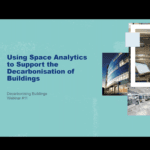
Accelerating Decarbonization through Space Analytics: A Vision for Sustainable Buildings
Embracing space analytics is a critical step towards achieving decarbonization goals and creating more efficient and sustainable buildings.
As we venture into a future where sustainability is paramount, there comes a pressing need for innovative solutions that can help us achieve our decarbonization goals. In this blog, we will delve into the world of space analytics, driven by advanced IoT sensor technology, sharing Enlighted’s Head of Sales, Europe, Niko Kavakiotis’s insights given during SSE’s webinar, Using Space Analytics to Support the Decarbonization of Buildings.
Introduction
It’s no secret that buildings are at the center of our lives as we spend 90% of our time inside building environments. However, these same buildings are significant contributors to more than 33% of global greenhouse gas emissions, driving industries and experts to seek sustainable alternatives. By harnessing the power of IoT sensor technology and analyzing space utilization data, we can make informed decisions to reduce carbon emissions and optimize building operations.
In his recent TedX Talk, Niko Kavakiotis highlights how we can use advanced sensor technology to turn our buildings into thinking and feeling entities.
All buildings have rooms, and all rooms have lights. Any given ceiling can be turned into a smart, thinking ceiling by strategically placing sensors with a processor as powerful as early versions of the iPhone next to light fixtures. These sensors can sense, think, remember, and most importantly, act.
By transforming buildings into intelligent ecosystems, we can gather important insights to maximize energy efficiency and contribute to decarbonization efforts.
Sensor Technology: Enabling Insightful Data Collection
Space analytics heavily relies on sensor technology to gather real-time data on various aspects of building operations. When Enlighted’s advanced IoT sensors are strategically placed throughout a building, they can capture invaluable information about occupancy levels, energy consumption patterns, and overall space usage. By deploying Enlighted’s technology, businesses can monitor building performance, identify inefficiencies, and implement targeted solutions for energy reduction, reducing energy waste and subsequently decreasing carbon emissions.
Practical Applications of Space Analytics
While the concept of space analytics may seem abstract, it has numerous practical applications that can support the decarbonization of buildings across various sectors including commercial real estate, education, healthcare, industrial, and data centers.
One particular area where space analytics has shown immense potential is in optimizing campus space utilization. Traditional office spaces and university campuses often witness fluctuating occupancy rates, with certain areas being underutilized while others are overcrowded. By installing Enlighted sensors strategically, businesses can gather comprehensive data on which areas are frequently occupied and which remain unoccupied for long periods of time. This information empowers decision-makers to reconfigure their spaces, ensuring a more efficient and sustainable use of resources.
For example, universities like the University of Birmingham face unique challenges in reducing carbon emissions and creating more energy efficient campuses. With over 200 buildings all over 100 years old, the University of Birmingham is on a mission to become the most energy-efficient campus in the world and achieve their goal of becoming Carbon Net Zero by 2030. By utilizing space analytics, they can optimize space allocation, predict occupancy patterns, and identify areas where energy consumption can be reduced during off-peak periods. This not only enhances the sustainability of the university campus but also improves financial efficiency and the overall occupant experience.
Moreover, space analytics enables building operators to implement targeted measures such as directing occupants to alternative spaces during low-demand periods. By leveraging data and controls, businesses can make intelligent decisions to optimize resource usage, resulting in lower carbon emissions and enhanced sustainability.
Conclusion
The impact of space analytics, driven by sensor technology goes beyond efficiency gains; it drives a fundamental transformation in the way we design, construct and manage the built environment. Niko Kavakiotis asserts, the future lies in turning buildings into intelligent entities that continuously adapt to our needs, making our lives easier while contributing to a greener future. Embracing space analytics is a critical step towards achieving decarbonization goals and creating more efficient and sustainable buildings.
The brightest way to operate, orchestrate, and optimize everyday spaces.



